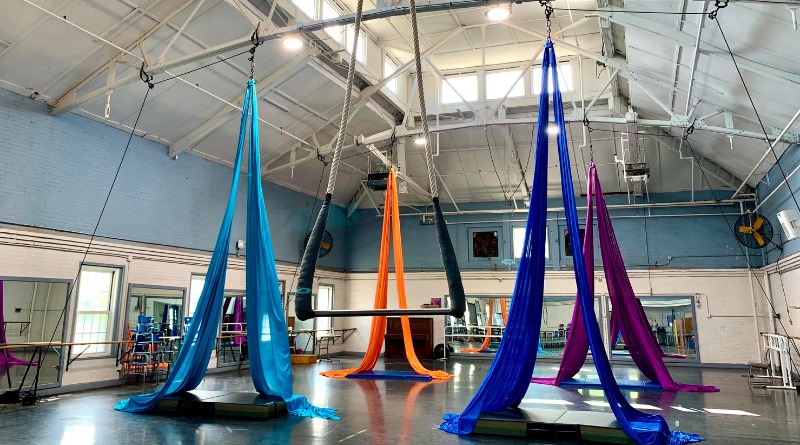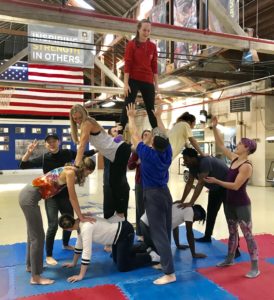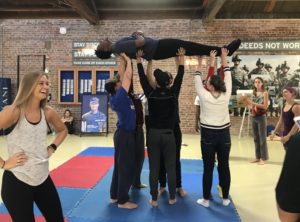Circus and Philosophy: Teaching Aristotle Through Juggling

Here’s something you may not know about academic philosophy: subjects such as philosophy of art, philosophy of sport, or philosophy of the performing arts are often taught without having the students engage in the activities or artforms that are being philosophized about. Students talk about paintings, but don’t paint; they talk about sports, but don’t play – in short, they theorize about an activity they don’t participate in. This approach is unfortunate and in desperate need of change. My course, Circus and Philosophy, is designed to explore the gap between thinking and doing.
I divide the course into two kinds of classes: activity-based days – when guest instructors teach circus skills such as juggling, aerial arts, and acro-balancing – and more traditional, discussion-based days, when we read, think through, and discuss philosophy. Students don’t just learnabout the circus, they learn how to circus.
But why circus, specifically? Surely the participation/theorizing gap could be explored just as easily through painting, singing, acting, or running. For those brand new to circus, attempting circus skills is playful, not competitive. No one cares if you can actually do the skills or not, or if you can do them well. The fun is in the trying. So unlike painting, singing, or dancing, where we often encounter the attitude “if you aren’t good at it, there’s no point in doing it,” there’s very little ego or status attached to doing circus. We’reexpected to suck at it. The bars are low, the activities are accessible; participation is easy.

Circus, as a discipline, can be characterized in a number of interesting ways: as art,bad art, performance or performance art, as mere spectacle and cheap thrills; as an activity requiring expert athleticism, or as an art form with a complicated, sometimes dark history of social injustice, workers rights, animal rights, bodily and gender identity. At times, it exemplifies diversity and inclusivity, at other times, exploitation. Circus also has an intriguing aesthetic evolution — from the three-ringed razzle dazzle oftraditional circus to the more intricate and provocative nuances of new and contemporary circus. The art form has also branched into communities via recreational exercise and social circuses. All of these features make the circus rich with potential for deep discussions about an array of philosophical topics in aesthetics, ethics, social and political philosophy, personal identity, mind, metaphysics, epistemology, and so on. It is also intrinsically interdisciplinary, so students with interests and majors outside of philosophy can easily find a way in.
The very first day of the course is a juggling lesson.Very few (if any) of the students already know how to juggle. Many mumble about how uncoordinated they are, how they will never be able to do it. Nonetheless, the juggling balls are distributed, and the lesson begins.
Our visiting instructor, Jesse AlFord, tells them to start with one ball. As the students toss (and drop) the one ball, Jesse gives advice, comments on technique and common mistakes, and talks about the skills involved in doing something so seemingly simple. Throughout his lesson, there’s a consistentthump-thump-thud of balls falling to the ground. Slowly, students get more comfortable with messing up. Then, Jesse invites them to try two balls, with the proviso that they can always come back to one if two isn’t working. From two, we move to three; from three, four. By the end of the 75-minute class, all of the students have tasted a bit of success. Most of them leave thinking that they might be able to juggle after all. They have been given the basic skills – and three juggling balls – to take home with them. They’ve been encouraged to practice.
The next day, we discuss Aristotle’sNicomachean Ethics. We explore the idea of moral virtue being more like learning a craft, an art form, or learning how to juggle. We talk about repetition and habits more generally, and how they establish habits in their own lives. Then we talk about how such things might contribute to virtue, happiness, or the good life. Quite frankly, it’s the usual run-of-the-mill introductory Aristotle stuff. There’s nothing particularly original about the philosophical content itself. Yet it makes all the difference to present this content directly after a juggling lesson in which the students literally began cultivating a habit and acquiring a physical skill – a skill that is initially incredibly awkward and unintuitive for nearly everyone in the class. In just 75 minutes of trying, students realize: practice does bring improvement.
That’s one of the main points of teaching philosophy in this way – to make philosophy tactile. Several students have remarked to me that because they understand themselves to be kinesthetic learners, they have difficulty in traditional ‘theory-only’ classes (such as philosophy) and usually avoid them at all costs. Teaching philosophy through first-person circus not only makes the subject attractive to students who might otherwise avoid philosophy, it helps students absorb the material differently.

Teaching Aristotle through juggling is just one example. Other material is more directly integrated with circus as a performing art. InActs: Theater, Philosophy, and the Performing Self, Tzachi Zamir proposes that “a person is a cluster of possibilities, and actualizes a small portion of these.” He suggests that through theater and acting one can amplify themselves, leading to a wider range of opportunities or ‘live options’ in real life. Zamir calls this “existential amplification.” Acting (not merelyobserving acting) can help someone better understand themselves as they actually are against a broadened backdrop of what’s possible for them.
These philosophical ideas are paired with lessons on acting, stage presence, and character development. Most of the students have not had much experience in the performing arts. Nonetheless, with guidance, they act and improvise, while reflecting on personal identity, potential, and possibility. We then talk about who they think they are (in everyday life) in contrast to who they think theycould be, given the character they’ve just played. Certainly, these same ideas could be taught in a traditional classroom setting where the philosophical arguments and conclusions can be introduced and analyzed a priori. Yet the activity-based approach allows students to experience a direct application of the concepts
In Contemporary Circus, the authors explain how innovative, contemporary acts are challenging traditional views about the relationship between circus artists and apparatus. Departing from the idea that an apparatus is something to overcome, or a tool to showcase the performer’s prowess, innovative acts are done “using apparatus made from materials such as ice and clay, which are mutable and transform during the performance, or virtual apparatus which allows the performer and the audience to interact with invisible forces, such as infrared beams,” which allows us to question our usual assumptions about what an apparatus is or is supposed to be.
Contemporary circus also examines the relationship between the artist and apparatus – even going so far as to propose that the identity of the circus artist literally includes the apparatus itself. This suggests an intriguing parallel between the artist-apparatus relationship in circus and the mind-body relationship in philosophy. The authors ofContemporary Circus explicitly reference Clark and Chalmers’ “The Extended Mind” (1998), and theories of extended cognition, which leads our class to substantive discussions about the mind-body problem and consciousness. It gives students an unexpected springboard into classical debates in philosophy of mind, while simultaneously allowing them to explore the artist-apparatus relationshipfor themselves, as they whirl around on a spinning lyra.
Clearly, a crucial component of this class is the students’ first-personexperience in doing these new-to-them (thus often terrifying) activities. As circus is becoming more accessible – as more gyms and fitness studios are offering anyone a chance to climb silks or get on a lyra, and recreational flying trapeze companies are offering flight classes for any daring soul who’s willing – more people are experiencing first hand what it’s like todo circus, instead of merely taking a look. And, by most accounts, it is amazing.
InThe Ordinary Acrobat, Jonathan Conant, a founder of Trapeze School New York, describes the flying trapeze as “a machine for helping people re-evaluate what they are capable of…Before a flight, people are invariably uncomfortable. They’re pissed off, they’re scared, they’re sad. There’s a real fear of getting hurt.” They think that the trapeze is “magical. It’s unattainable. It’s completely out of the realm of possibility for most people’s minds.” Yet after flying, “[t]here’s an evolution, an acceptance of what’s possible. The trapeze is so built up in people’s heads. And then someone says, ‘You can actually do this, too.’ That totally shifts the realm of what’s possible.” Circus literature is rich with such accounts, especially in connection to the flying trapeze. Very often, there is talk of a great shift in perspective, of seeing the world differently, experiencing life anew, and even becoming a whole new being.
Philosopher L. A. Paul might characterize such perspective-shifting events astransformative experiences – experiences that both epistemically and personally transform us. According to Paul, given the utter newness of such experiences and the personal changes that occur because of them, we may lack the epistemic means needed to make a fully rational decision about whether to undergo the experience in the first place.

Alas, it is not in my (current) course budget to arrange for my students to go whooshing about on the flying trapeze. But for many, dangling on a dance trapeze, climbing a rope, inverting on aerial fabric or spinning in a lyra can be just as intimidating, just as terrifying, and exhilarating as the grand sweep of a trapeze flight. Consequently, this class not only offers an opportunity for students to learnabouttransformative experiences, it has the potential to provide them with one. (Although, if Paul is right, none of them can rationally choose to undergo it.)
Apart from the vast array of topics that a class such as Circus and Philosophy can cover, let me conclude with two other benefits of teaching philosophy this way.
First, the classroom atmosphere in this course is unlike my traditional philosophy classes. It’s not that my students don’t trust each other or help each other out or aren’t respectful of each other in, say, my advanced symbolic logic course. They do and they are. But the level of interaction and trust needed to physically lift up a classmate above their heads goes beyond merely respecting someone else’s point of view. Moreover, the philosophical discussions after acro-balancing sessions are markedly different in tone than they usually are in traditional philosophy classrooms. The students appear to listen to each other more earnestly and interpret differing views more charitably.
I suppose this should be expected. If, during a philosophical discussion, you are thinking “oh hey, that person literally lifted me up the other day and held me, safely and securely, off of the ground,” you probably will be inclined to listen to them a bit more graciously when they share their thoughts on life, the universe, and our place in it. Physically trusting in (and being trusted by) fellow classmates easily transfers to being more intellectually trusting with new and different ideas. This lends to a general classroom environment of cooperation and respect – an outcome similar to the overwhelming success of social circus’s ability to build networks of community support and instill confidence, independence, adaptability and communication skills.
Second, the circus has a reputation and record of being a welcoming place for an incredibly diverse population. People of all types, identities, ages, backgrounds, shapes and sizes, talents, and beliefs are embraced and celebrated in the circus. The impressive variety of acts and activities that are (and have been) constitutive of the circus has helped to create the most inclusive community around. This class follows suit. It attracts a notably wider range of students than my usual classes.
Teaching philosophy through circus clearly benefits philosophy, but – importantly, as my students have shown me – the reverse is also true: philosophy helps highlight the intellectual depth and wonder of circus. It is a symbiotic exchange, one that is exemplary of what can happen when we close the gap between thinking and doing.
A version of this article was originally published on December 2, 2021 by Aesthetics for Birds. This is revised and reprinted with permission.
Editor's Note: At StageLync, an international platform for the performing arts, we celebrate the diversity of our writers' backgrounds. We recognize and support their choice to use either American or British English in their articles, respecting their individual preferences and origins. This policy allows us to embrace a wide range of linguistic expressions, enriching our content and reflecting the global nature of our community.
🎧 Join us on the StageLync Podcast for inspiring stories from the world of performing arts! Tune in to hear from the creative minds who bring magic to life, both onstage and behind the scenes. 🎙️ 👉 Listen now!
